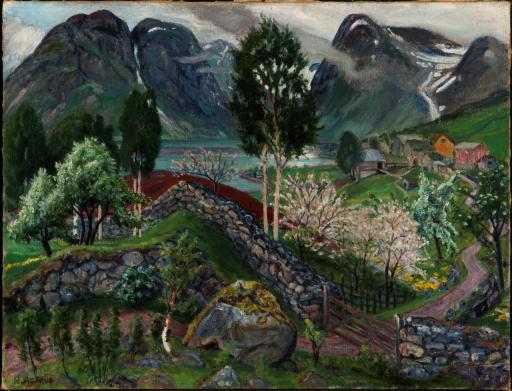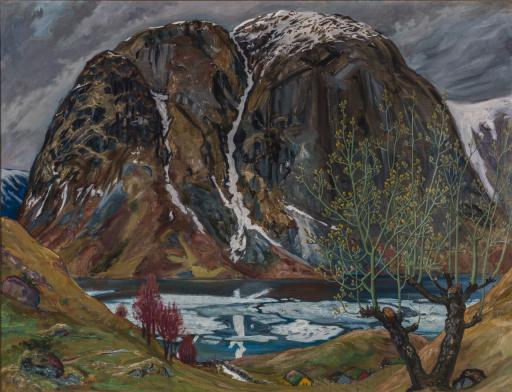Provenance
1905-1909:
Artist
Nikolai Astrup
(1880-1928)
1908-1908:
In custody of
Ole Johannessen
(1857-1948)
1909-1916:
Privately purchased by
Rasmus Meyer
(1858-1916)
1916-1916:
By descent, to
Finn Meyer
(1892-1965)
1916-1916:
By descent, to
Gerda Nyquist
(1889-1964)
1916-current:
Rasmus Meyers samlinger
1950-1989:
Bergen kommunale kunstsamlinger
1989-2006:
Bergen Kunstmuseum
2006-current:
Kode Kunstmuseer og komponisthjem
Exhibition history
Solo exhibition
1928-11-11 - 1928-12-9
Nikolai Astrup. Mindeutstilling
Kristiania (Oslo)
Catalogue number 6
See exhibition
1980-3-14 - 1980-4-7
Nikolai Astrup 1880–1928. Maleri, tegning, grafikk
Bergen
Catalogue number 24
See exhibition
1980-4-12 - 1980-5-4
Nikolai Astrup 1880–1928. Maleri, tegning, grafikk
Oslo
Catalogue number 24
See exhibition
1980-6-4 - 1980-6-29
Nikolai Astrup 1880–1928. Maleri, tegning, grafikk
Trondheim
Catalogue number 24
See exhibition
1980-8-30 - 1980-9-1
Kunstnaren Nikolai Astrup (1880-1980)
Vassenden, Jølster
Catalogue number 27
See exhibition
2016-10-2 - 2017-1-22
Nikolai Astrup: Norwegen. Eine Entdeckung
Emden
Catalogue number 12
See exhibition
2026-11-21 - 2027-1-31
Nikolai Astrup - Garden of Growth (Tokyo)
Catalogue number [none]
See exhibition
2027-6-17 - 2027-9-12
Nikolai Astrup - Garden of Growth (Nagoya)
Catalogue number [none]
See exhibition
2027-10-2 - 2027-12-26
Nikolai Astrup - Garden of Growth (Hayama)
Catalogue number [none]
See exhibition
Group exhibition
1976-11-13 - 1976-12-4
Norwegian Romantic Landscape 1820–1920
NewcastleuponTyne
Catalogue number 6
See exhibition
1976-12-17 - 1977-1-16
Norwegian Romantic Landscape 1820–1920
Liverpool
Catalogue number 6
See exhibition
1977-2-12 - 1977-4-9
Norwegische Landschaftsmalerei. Von Dahl bis Munch
Bremen
Catalogue number 6
See exhibition
1984-1-13 - 1984-3-11
The Mystic North: Symbolist Landscape Painting in Northern Europe and North America 1890–1940
Catalogue number 78
See exhibition
1984-3-31 - 1984-5-13
The Mystic North: Symbolist Landscape Painting in Northern Europe and North America 1890–1940
Catalogue number 78
See exhibition
1998-4-3 - 1998-6-5
Landschaft als Kosmos der Seele: Malerei des nordischen Symbolismus bis Munch 1880–1910
Köln
Catalogue number 2
See exhibition
2008-2-7 - 2008-5-4
Fjellet i norsk kunst: Oppdagelse, formasjon, visjon
Catalogue number 16
See exhibition
Bibliography
Bergens kommunale kunstsamlinger. Rasmus Meyers Samlinger. Katalog. Bergen: Bergens kommunale kunstsamlinger, 1978 [1955].
Bergens kunstforening. Katalog over Nikolai Astrups Maleriutstilling. Bergen: Bergens kunstforening, 1908.
Künstlerbund Hagen. Norwegische Künstler. Wien: Hagenbund, 1912.
Loge, Øystein. Betrothed to Nature. Oslo: Det Norske Samlaget, 2010.
Haavardsholm, Frøydis. Nikolai Astrup. Oslo: Gyldendal, 1935.
Carey, Frances; Dejardin, Ian A. C.; Stevens, MaryAnne (ed.). Norske landskap. Nikolai Astrup (1880–1928). London: Scala Arts & Heritage Publishers Ltd, 2016.
Carey, Frances; Dejardin, Ian A. C.; Stevens, MaryAnne (ed.). Painting Norway. Nikolai Astrup (1880–1928). London: Scala Arts & Heritage Publishers Ltd, 2016.
Stevens, MaryAnne, et al. Nikolai Astrup. Visions of Norway. Williamstown, Massachusetts: Clark Art Institute, 2021.
Stevens, MaryAnne, et al. Nikolai Astrup. Rå natur. Bergen: KODE, 2021.
Loge, Øystein. Gartneren under regnbuen. Hjemstavnskunstneren Nikolai Astrup. Oslo: Dreyers Forlag, 1990 [1986].
Johannesen, Ole Rønning. «Nikolai Astrup som Bjørnson-illustratør. Til 100-årsjubileet for Bjørnsons bondefortellinger». Kunst og kultur 40, (1957): 231–246.
Askeland, Jan. «Nikolai Astrup og kunsten». In Nikolai Astrup 1880–1928, ed.: Jølster kommune, 16–33. Jølster: Jølster kommune, 1970.
Eikås, Kristian. «Nikolai Astrup og Jølster». Syn og segn 49, (1943): 232–241.
Kinck, Hans E.. «Litt om Nikolai Astrup». Kunst og kultur 1, (1911): 233–241.
Lexow, Einar. «Nikolai Astrup». Kunst og kultur 15, (1928): 193–212.
Alsvik, Henning og Leif Østby (ed.). Norges billedkunst i det nittende og tyvende århundre. Bind I. Oslo: Gyldendal, 1951.
Korsvold, Per. «Maleren fra Jölster». Samleren, 8 (1931): 101–108.
Harbitz, Alf. «Nikolai Astrup». Ord och Bild, (1929): 617–623.
Gram, Nina. «Nikolai Astrup på Europa-turné». Aftenposten Historie 2016, 2 (2016): 66-73.
Askeland, Jan. Norsk malerkunst. Hovedlinjer gjennom 200 år. Oslo: J. W. Cappelens Forlag, 1981.
Østby, Leif. Norges kunsthistorie. Oslo: Gyldendal Norsk Forlag, 1977 [1938].
Haugsbø, Tove. «Fortida gjennom notida. Nikolai Astrups kunst i nye perspektiv». Unpublished thesis. PhD. Bergen: University of Bergen, 2015.
Greve, Kari. «Nikolai Astrup: Visions of Norwegian Nature». The Burlington Magazine 164, 1428 (2022): 302-305.
Ellefsen, Jenny Sandmo. «Nikolai Astrup for nye øyne. En analyse av utstillingen 'Nikolai Astrup: Painting Norway'». Unpublished thesis. Master. Oslo: Universitetet i Oslo, 2018.
Haugsbø, Tove. «Med samtida som ståstad. Ei aktualiserande lesing av Nikolai Astrup sin produksjon». Unpublished thesis. Master. Bergen: Universitetet i Bergen, 2010.
Ødvin, Magnhild. «Nikolai Astrup 1880–1928». American-Scandinavian Review, (1930): 606–611.
Dejardin, Ian A. C.. «Painting Norway: Nikolai Astrup and the Jølster Project». In Painting Norway. Nikolai Astrup (1880-1928), ed.: Carey, Frances; Dejardin, Ian A. C.; Stevens, MaryAnne, 13–23. London: Scala Arts & Heritage Publishers Ltd, 2016.
Dejardin, Ian A. C.. «Norske landskap: Nikolai Astrup og Jølster-prosjektet». In Norske landskap. Nikolai Astrup (1880-1928), ed.: Carey, Frances; Dejardin, Ian A. C.; Stevens, MaryAnne, 14–23. London/Oslo: Scala Arts & Heritage Publishers Ltd, 2016.
Stevens, MaryAnne. «Nikolai Astrup: National/International». In Painting Norway. Nikolai Astrup (1880-1928), ed.: Carey, Frances; Dejardin, Ian A. C.; Stevens, MaryAnne, 25–43. London: Scala Arts & Heritage Publishers Ltd, 2016.
Stevens, MaryAnne. «Nikolai Astrup: nasjonal og internasjonal». In Norske landskap. Nikolai Astrup (1880-1928), ed.: Carey, Frances; Dejardin, Ian A. C.; Stevens, MaryAnne, 25–43. Oslo/London: Scala Arts & Heritage Publishers Ltd, 2016.
Stevens, MaryAnne. "He Paints His Western Lands as No One Else Painted Them Before": The Art of Nikolai Astrup. In Nikolai Astrup. Visions of Norway, ed.: Stevens, MaryAnne, 36-53. Massachusetts: Clark Art Institute, 2021.
Stevens, MaryAnne. "«Han maler sit Vestland nu som før, og som ingen har malt det»: Nikolai Astrups kunstnerskap". In Nikolai Astrup: Rå natur, ed.: Stevens, MaryAnne, 36-53. Williamstown, Massachusetts: Clark Art Institute og Fagbokforlaget, 2021.
Danbolt, Gunnar. Norsk kunsthistorie. Oslo: Samlaget, 2009 [1997].
Loge, Øystein. Deformasjon. Nedbrytningen av det klassiske naturbildet i norsk landskapskunst: Peder Balke, Lars Hertervig, Edvard Munch, Nikolai Astrup. Oslo: Dreyers Forlag, 1991.
Thiis, Jens. «Malerkunsten i det 19. og 20. aarhundrede». In Norsk kunsthistorie, ed.: Aars, Harald; Brøgger, A. W.; Bugge, Anders; Fett, Harry; Grevenor, Henrik; Kielland, Johan Meyer; Nygaard Nilssen, Arne; Schnitler, Carl W.; Shetelig, Haakon; Visted, Kristofer, 389–598. Oslo: Gyldendal, 1927.
Lexow, Einar. Norges kunst. Oslo: Steenske Forlag, 1942 [1926].
Stenstadvold, Håkon. Norsk malerkunst i norsk samfunn. Oslo: Dreyers Forlag, 1960.
Askeland, Jan. Rasmus Meyers Samlinger. Bergen: [Bergen kommune], 1966.
Jor, Finn. «Forhekset virkelighet. Nikolai Astrup (1880–1928)». In Norske kunstnerhjem, ed.: Jor, Finn; Havran, Jiří, 78–83. Oslo: Boksenteret, 1997.
Loge, Øystein. «Den fremmede i fjellbygden». In Nikolai Astrup. Tilhørighet og identitet, ed.: Wexelsen, Einar; Danbolt, Gunnar; Loge, Øystein, 5–15. Oslo: Labyrinth Press, 2005.
Danbolt, Gunnar. «Nikolai Astrup – en maler på tilgroede stier». In Drømmebilleder, ed.: Damsbo, Mads, 10–27. København: Narayana Press, 2010.
Nasgaard, Roald. «Norway: Edvard Munch, Harald Sohlberg and Nicolay Astrup». In The mystic North: symbolist landscape painting in Northern Europe and North America 1890-1940, ed.: Nasgaard, Roald, 92–122. Toronto: University of Toronto Press, 1984.
Lofnes, Solveig Berg. Nikolai Astrup og Jølster. Førde: Selja Forlag AS, 2016.
Danbolt, Gunnar. "Prins Eugen, Nikolai Astrup og Ulf Nilsen – en studie i kontakt og kontrast". In Drømmesommer: Prins Eugen 1865–1957, Nikolai Astrup 1880–1928, Ulf Nilsen f. 1950, 40-102. Vikersund: Stiftelsen Modums Blaafarvaværk, 2009.
Stiftelsen Modums Blaafarveværk (ed.). Nikolai Astrup 1880–1928. Modum: [s.n.], 1987.
Loge, Øystein. "Nikolai Astrups landskap". In Nikolai Astrup 1880-1928, 12-25. Vikersund: Stiftelsen Modums Blaafarveværk, 1987.
Loge, Øystein. Nikolai Astrup. Elskaren under trekrona. Oslo: Det Norske Samlaget, 2005.
Czymmek, Götz; Marit Ingeborg Lange. Landschaft als Kosmos der Seele: Malerei des nordischen Symbolismus bis Munch 1880–1910. Heidelberg: Wallraf-Richartz-Museum, 1998.

